-
Car Reviews
- All reviews
- Midsize SUVs
- Small cars
- Utes
- Small SUVs
- Large SUVs
- Large cars
- Sports SUVs
- Sports cars
- Vans
Latest reviews
- Car News
-
Car Comparisons
Latest comparisons
- Chasing Deals
Hyundai’s facelifted, plus-sized SUV aims upmarket in lavishness and pricing. But does the ultimate Highlander diesel’s experience match the semi-premium swagger?
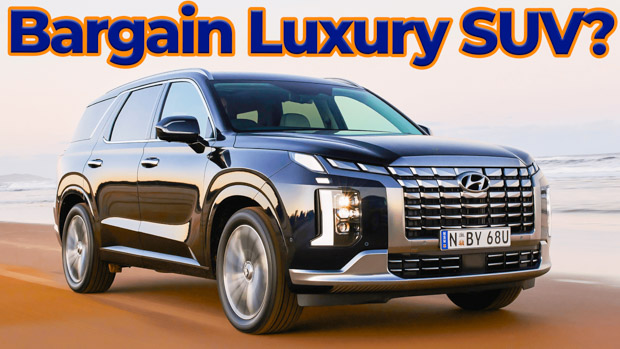
Hyundai’s steady march deeper into premium territory isn’t without tricky negotiation as demonstrated by its newly facelifted flagship Palisade range, in particular the top dog Highlander AWD diesel guise. Its refreshed styling compliments higher equipment levels and increased pricing as the rising tide lifts all ships.
Still, the luxury wagon still appears family-friendly champagne on certifiable beer money against the likes of Mercedes-Benz GLS it hopes to rob buyer interest from.
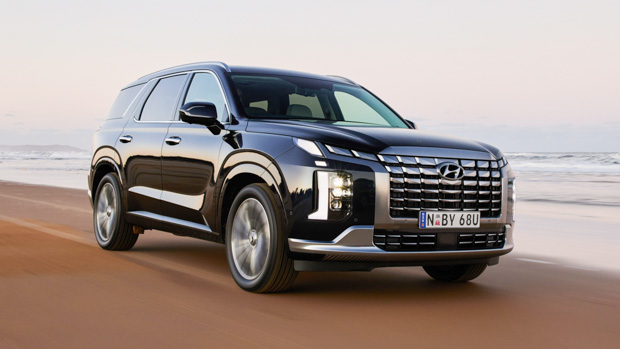
Its five-metre-nudging, Americana-tinged form arguably plies much more charisma than the logical Kia Carnival or Nissan Pathfinder cross-shops and it’s won over many Aussie buyer hearts.
Remarkably, the Palisade proved popular enough in pre-facelift to outsell its smaller, more affordable and critically accomplished Santa Fe sibling in Oz throughout the first six month of 2022. Few (six percent) bought the now-defunct base version, while most were big-ticket Highlander AWD oilers our review version replaces.
So, what gives? And in both senses. What are the qualities that have deservedly driven the Aussie groundswell of interest in Hyundai’s grandest offering. And, importantly, where are the compromises in a package that, despite a rough five-grand price hike, sees the diesel Highlander’s $79,900 list price effectively half that of the tip-in point for a Benz GLS?
Safety and tech upgrades are the primary pushes for Palisade’s facelift, with powertrain and chassis ride and handling served polishing rather than much in the way of significant change. The result? An on-road experience that sways between genuine comfort and general competency, depending on how and where you’re driving and using it.
The evergreen 2.2-litre musters up an adequate 147kW and solid 440Nm, varying its enthusiasm throughout various drive modes if clearly most at home at a moderate throttle where character is polite and real-world consumption, at 7.3L/100km claimed, pretty close to the money.
There’s a fettled eight-speed auto, for smoother operation, though short of old-and-new comparison it’s tough to discern much difference or improvement.
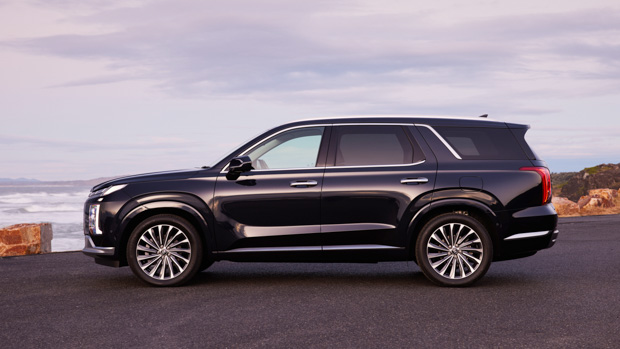
It’s willing enough, two up with minimal luggage. But dig in to overtake or, at one point during a few hundred kays of mixed driving, when exiting a sideroad into 110km/h signposted traffic, the oiler moves heaven and earth to drum up solid acceleration, with a correspondingly raucous soundtrack.
Loaded up loved ones and travel swag, as nature intended, this eight-seater undoubtedly demands patience and deft judgment from its driver.
The Palisade remains passively damped, albeit with new ‘selective frequency’ floating-valve damping that replaces the old fixed-valve design to yield a more relaxed ride. Meanwhile, spring rates were revised to improve road holding and body control, a Palisade strong suit to date.
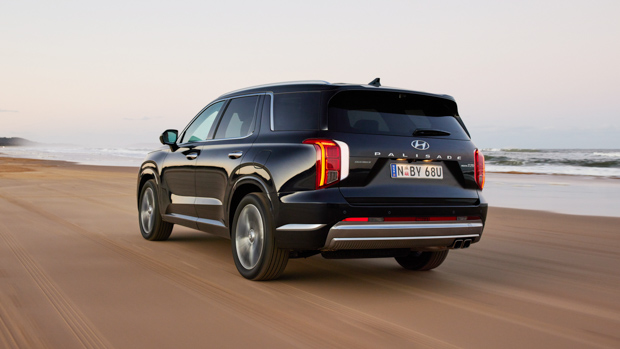
As with pre-facelift, it’s a global tune validated – rather than specifically developed – for Oz and magic if there’s synergy in the spring/damper interplay. And yet it’s not quite there…
Primary ride gets caught jarring across big hits while secondary ride across high-frequency road imperfections does get fizzy. Balance seems a little too skewed towards handling focus rather than the sort of cushioning compliance not unexpected from a luxury-leaning SUV.
It settles wonderfully on the open road, its considerable 2070kg (kerb) inertia ironing out lumpier hotmix nicely, though such is the nature of most large, hefty unibody wagons. It’s really the slower-going, urban environment that flusters its road-going manner a little too much.
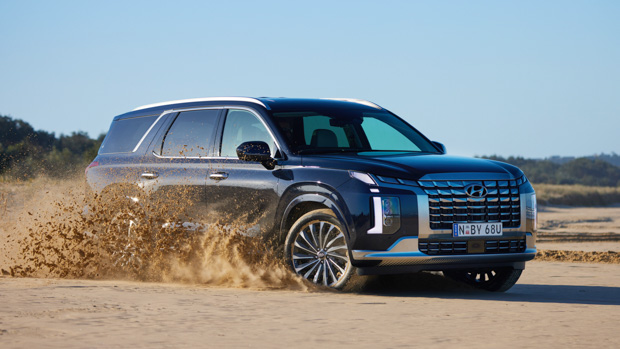
Adaptive damping? That’s higher-dollar Genesis territory, though not an unreasonable ask for Highlander’s circa $80k ticket. If there’s a fair criticism of the high-spec variant, it’s that there’s really nothing much under the skin, in running gear, to separate it from the lower-grade Elite AWD that’s $10k thriftier on the hip pocket.
More sound insulation, thicker rear glass, improved window seals, new bearing, rubbers and myriad other addenda conspire to improve refinement from what was a pretty decent Palisade base. But on the move, there’s a conspicuous amount of tyre noise and the odd knock of suspension noise.
It’s good. Quite good. But for the upmarket promise, the degree of tangible on-road polish is perhaps better reflected in its price point than its foreboding street presence.
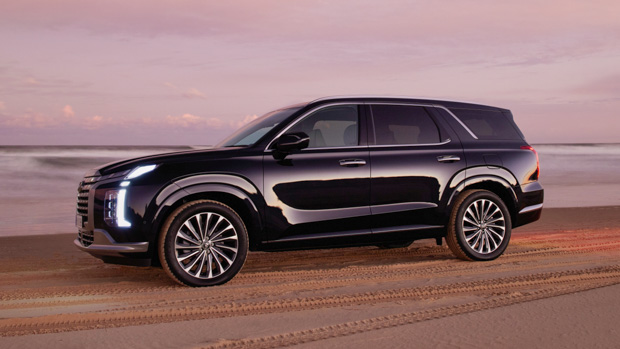
The elevation from a four- to five-star ANCAP rating is a significant one with Aussie buyer perception, facilitated primarily via the fitment of a front-centre airbag – for a total of seven – and junction turning functionality for the forward AEB.
Reverse parking collision avoidance, multi anti-collision braking, SOS/collision notification (to a call centre) and intelligent speed limit assist are all new inclusions that go some way in justifying the wider Palisade range’s price hiking, a $5009 upcharge in our Highlander AWD.
But added safety does prove added annoyance in the drive. The overspeed advisory warning, that rearms every start-up and is a chore to disarm, is downright infuriating. And every journey is punctuated by a litany of chimes and tones to alert the driver of, well, something of concern, if with no further visual explanation or warning message.
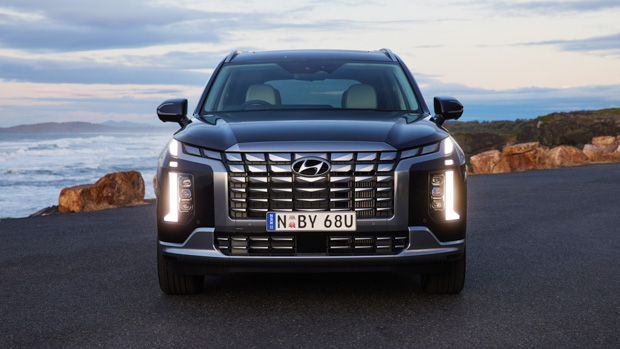
That said, the multi-camera system is excellent and the reverse light guide feature, illuminating rearward progress in the dark, is very helpful when negotiating the Palisade’s considerable form into inconsiderable parking spaces.
As for high-spec’s digital rearview mirror, I didn’t see any cause during my week with the SUV that warranted its camera-based perspective. Nor is your author the type who favours the novel blind-spot monitor display system beamed via the digital instrumentation any advantage over good, old-fashioned wing mirrors.
A year ago we called the old Highlander “the most luxurious interior we’ve ever seen on a Hyundai.” And the facelifted version is nicer still, partly in its more contemporary styling theme, partly due to flashier digital window dressing.
The dual 12.3-inch displays really lift the top dog Palisade’s tech appeal. Better yet, rather than the trendy flat-panel effect spruiked by motoring’s trend-setters, the driver’s screen is countersunk for what is, frankly, a more pleasingly conventional look without robbing the cabin of digi-slickness. Nice.
Hyundai’s new-look signature four-spoke wheel and full-width, horizontal air vent dash fascia design bring a real freshness to what was already a very appealing high-street cabin theme.
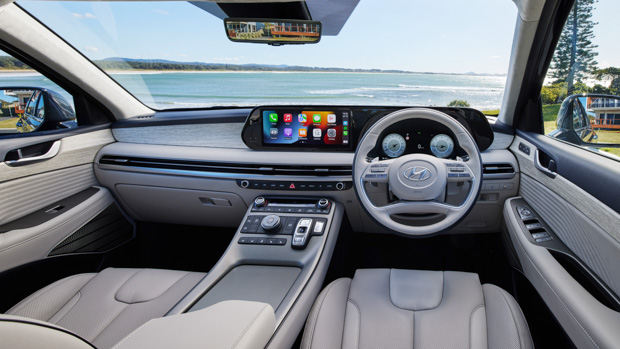
The push-button transmission selector, quality of the controls and cleanliness of the interior layout is inspired. And from top to (anatomical) bottom, the suede headlining and (parital) nappa leather trim, the Highlander confidently steps into premium territory.
And yet, it’s no Genesis. From the general ambience down to the material execution, such as the conspicuously fake looking and feeling wood inserts, it is, with the fullest respect, certifably Hyundai. And despite the top-spec version’s (choice of three) two-toned themes, quilted door inserts and diamond alloy surfacing that ape its premium GV cousins.
The Highlander’s interior feels suitably plush and extravagant enough for the sort of coin it asks for. Nothing more nor less. There’s devil in details, such as the more powerful 15-watt inductive phone charge pad and migration to USB-C outlets, though the front cubby still uses USB-A as Apple CarPlay and Android Auto mirroring is still wired.
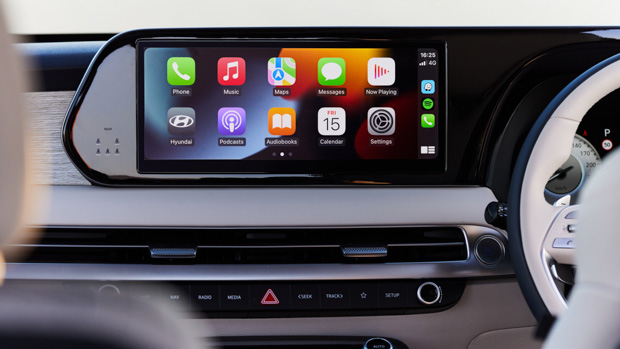
Meanwhile, the 10.25-inch touchscreen format is familiar Hyundai fare, content rich and reasonably intuitive to use.
The choice of seven or eight seats – the former swapping the row-two bench for two individual ‘captains’ chairs’ – remains inspired. Aussies love contingencies for a rainy day and the eight-pew configuration will remain the most pragmatic choice, but the seven’s four individual seating really adds an indulgent first-class vibe if you habitually have fewer loved ones to ferry about.
Despite 15mm-longer body work, there’s no cabin growth. Not that Palisade needed any. Our eight-seater’s split-slide and tilt second-row bench – now cooled and heated – offers ample roominess and tailor-fit comfort adjustment. Third-zone climate, clever USB ports in the front seat backs and ceiling mounted air vents are classy, family friendly inclusions.
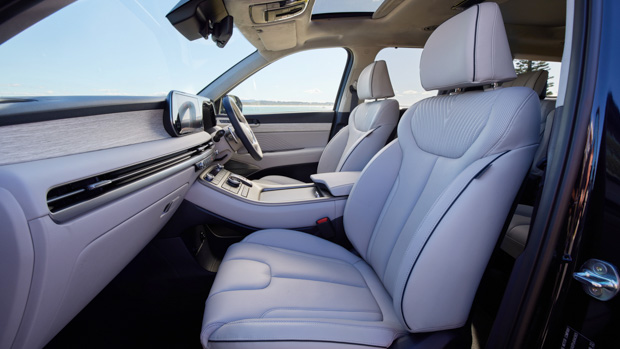
There’s oodles of storage, including a large hidden tray under the centre console for large items and small bags. Feeling thirsty? There are 13 cupholders, not counting the four door bin bottle receptacles.
Row three is considerably cosier: a three-child or two-adult format with any semblance of comfort. On the plus side, the Palisade offers proper three-row airbag coverage. Luggage space remains unchanged at a decent 311 litres with all seats in play that manually expands to 704L as a five-seater. There are handy controls on the rear cargo space that remotely drop row two seating when loading up from the tailgate.
So far, so conventional. But what’s genuinely new for Hyundai locally are the Bluelink connective services debuting on facelifted Palisade. Its subscription – first five years free – brings myriad bells and whistles.
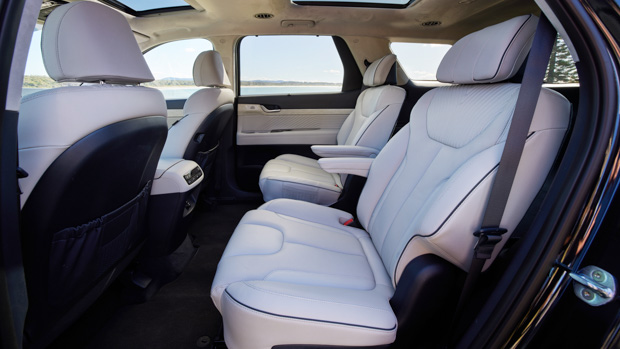
In-car Bluelink features include SOS/emergency call services, collision notification for emergency assistance, connected routing for the satnav and natural voice control. But there’s also a trick bag of remote phone app-connected conveniences, such as control of numerous vehicle functions, valet mode, calendar syncing, vehicle status checks and Find My Car for us forgetful types.
Necessities? For many, perhaps not. Though Bluelink does lay foundations for levels of connectivity long spruiked by premium Euros that Hyundai feels is a necessary quiver for its upmarket aim.
Against its 7.3L/100km combined consumption-claim, the diesel-powered Highlander returned a 7.5 figure after around 500 kilometres of assessed mixed driving. That’s a solid effort.
The temptation of potentially saving at the hip pocket by dipping down into the $4000 more affordable if certifiably thristier (10.7L claimed) 3.8 petrol front-driver could well prove false economy in the long burn of ownership.
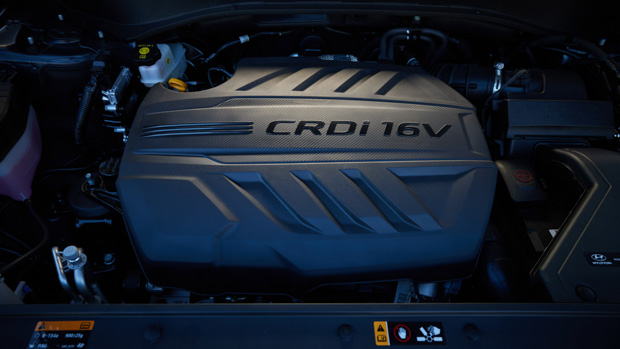
Hyundai offers capped-price servicing for the first five years at $489 per visit for each of its 12-month/15,000km servicing intervals. For comparison, the 3.8 petrol’s visits are $399 per interval.
The Palisade is covered by a five-year/unlimited-kilometre warranty in Australia.
It runs out that the plus-sized family hauler conspicuously targeting American buyers has struck a perhaps surprisingly sweet chord with Aussies. Its design swagger, big space, smart packaging combined with a pitch that’s more indulgent than ‘normal’ SUVs and more attractive than pure MPV praciality.
Despite some (now enhanced) multi-terrain smarts, no, it’s not really a substitute for a boat-lugging Land Cruiser, but nor does it need to occupy the same all-capable space on the motoring landscape.
In facelift, the Palisade doesn’t meddle with any existing core appeal. But it does more sharply address Aussie buyer tastes and the appetite to spend up on higher grades.
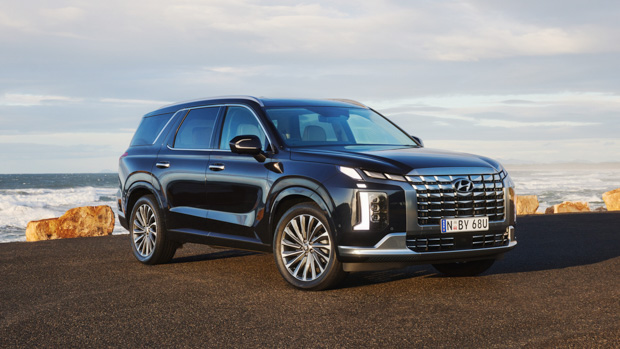
Ditching the poor-selling base model makes sense; loading the top-spec Highlander with more goodies and features, whether or no buyers want or need them, is at its core a reaction to local buyer trends.
What it’s not is a Genesis experience by another name and a considerable outlay. It walks and talks like an accomplished Hyundai offering and delivers a suitable flagship experience to the range. It’s priced fittingly or not over generously. And it’s certifiably nice while still demonstrating that, in some areas such as powertrain lust and ride comfort, it’s more adequate than gush-worthy.
In many ways the Palisade Highlander hits the marks for what it sets out to, if not without some room for improvement in its maker’s more premium aspirations.
Variant tested HIGHLANDER (8 SEAT)
Key specs (as tested)
About Chasing cars
Chasing Cars reviews are 100% independent.
Because we are powered by Budget Direct Insurance, we don’t receive advertising or sales revenue from car manufacturers.
We’re truly independent – giving you Australia’s best car reviews.
The estimate provided does not take into account your personal circumstances but is intended to give a general indication of the cost of insurance, in order to obtain a complete quote, please visit www.budgetdirect.com.au. Estimate includes 15%^ online discount.
^Conditions Apply
Budget Direct Insurance arranged by Auto & General Services Pty Ltd ACN 003 617 909(AGS) AFSL 241 411, for and on behalf of the insurer, Auto & General Insurance Company Limited(ABN 42 111 586 353, AFSL 285 571).Because we don’t know your financial needs, we can’t advise you if this insurance will suit you. You should consider your needs and the Product Disclosure Statement before making a decision to buy insurance. Terms and conditions apply.
Indicative quote based on assumptions including postcode , 40 year old male with no offences, licence suspensions or claims in the last 5 years, a NCD Rating 1 and no younger drivers listed. White car, driven up to 10,000kms a year, unfinanced, with no modifications, factory options and/or non-standard accessories, private use only and garaged at night.
^Online Discounts Terms & Conditions
1. Discounts apply to the premium paid for a new Budget Direct Gold Comprehensive Car Insurance, Third Party Property Only or Third Party Property, Fire & Theft Insurance policy initiated online on or after 29 March 2017. Discounts do not apply to optional Roadside Assistance.
2. Discounts do not apply to any renewal offer of insurance.
3. Discounts only apply to the insurance portion of the premium. Discounts are applied before government charges, taxes, levies and fees, including instalment processing fees (as applicable). The full extent of discounts may therefore be impacted.
4. We reserve the right to change the offer without notice.